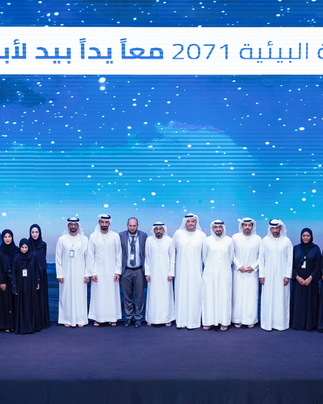The Environment Agency – Abu Dhabi (EAD) has a very extensive air quality monitoring network, centred around an accredited calibration laboratory, which underpins its quality assurance, control measures and procedures, resulting in high data quality.
The network is comprised of 20 fixed stations which monitor air quality with a very high data accuracy and an outstanding 99% capture rate. Also, there are two mobile stations used to conduct special air quality studies.
The network monitors a total of 275 parameters with 130,086,000 new minute-data points, provided annually. Over 1,561,032,000 valid data points are currently stored in the database and data is provided for more than 70 activities with a 30% year-on-year increase in data requests from key stakeholders such as local and federal government entities as well as academic institutions. The data is then broadcasted in real-time on a dedicated website which, over the past year, has seen 6,861 visits stemming from the UAE and 78 other countries (www.adairquality.ae).
Engineer Faisal Al Hammadi, Acting Executive Director of the Environment Quality Sector at EAD said: “Throughout 2021, we further expanded our monitoring programme to enhance and protect the air quality in Abu Dhabi where we recorded that 83% of the days of the year (or the equivalent of 303 days) adhere to the National Air Quality index limits. We also engaged with local institutions and international partners to increase our understanding of air pollutants and develop our monitoring and measurement strategies.”
He added “Throughout the year we had several achievements, such as successfully completing the 2020 Annual Ambient Air Quality report. This annual report on air quality in Abu Dhabi is based on data from our ambient air quality monitoring network. The 2020 data has been quality controlled and prepared as a basis for the statistics presented in the report, together with a comparison of monitoring results from earlier years. The network monitors up to 14 pollutants, 6 meteorological parameters and noise at the EAD air quality monitoring stations.”
Additionally, during the year EAD engaged with international partners, which included publishing the scientific paper, “The Influence of COVID-19 Preventive Measures on the Air Quality in Abu Dhabi”, which was published in Springer Nature. This paper is significant because during 2020, with the emergence of the Covid-19 pandemic and the precautionary measures taken to control it, EAD recorded a major improvement in the air quality of the emirate.
EAD also partnered with the World Health Organization (WHO) to join the Global Air Pollution and Health Technical Advisory Group (GAPH-TAG). The GAPH-TAG is considered a logical step towards the formalization of an Expert Group regularly convened through the Global Platform on Air Quality and Health. This has been WHO’s mechanism to facilitate the harmonization of data pertaining to air pollution and health and to strengthen countries’ capacity to address air pollution and related health risks since 2014.
Similarly, EAD participated in the 4th International Conference on Atmospheric Dust 2021 and celebrated the 2nd United Nations International Day of Clean Air for Blue Skies, where EAD conducted a technical workshop on the state of air quality in Abu Dhabi and engaged the general public through social media to walk towards a cleaner air for all.
Furthermore, EAD partnered with ADNOC to develop the Air Emission Monitoring and Measurement Strategy for Air Pollutants in ADNOC Group Companies, for emissions from the oil and gas sector. as Additionally, Abu Dhabi Ports and Emirates Global Aluminium are working closely with EAD to establish real-time data exchange of their ambient air quality monitoring networks with EAD’s monitoring system.
EAD also completed the Fine Particle Sampling and Source Identification in Abu Dhabi Study which was a major milestone for the Agency, Abu Dhabi and the UAE at large. The study provides a reliable scientific basis for developing air quality management plans; contributes to air quality forecasting and provides a better understanding of sand and dust storms. It also identifies relative contributions to fine particulate matter (PM2.5) composition from natural and anthropogenic sources and enables the effective assessment of health impacts.








